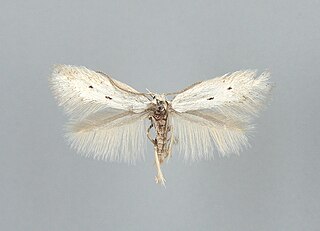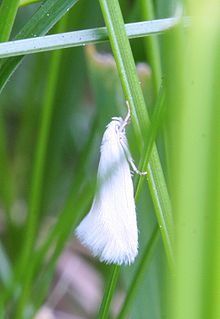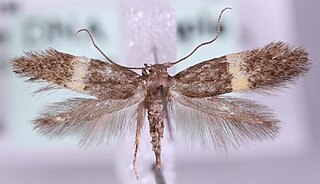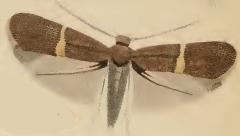
Apamea crenata, known as the clouded-bordered brindle, is a moth in the Noctuidae family. It is distributed throughout the Palearctic realm.

Apamea remissa, the dusky brocade, is a species of moth of the family Noctuidae. It is distributed throughout Europe and Turkey, ranging across the Palearctic realm to Siberia, Manchuria and Japan. It has also been reported from Alaska.

Coleophora flavipennella is a moth of the family Coleophoridae. It was described by Philogène Auguste Joseph Duponchel in 1843 and is found in Europe.

Leucania loreyi, the cosmopolitan, false army worm or nightfeeding rice armyworm, is a moth of the family Noctuidae. It is found in most of African countries, the Indo-Australian subtropics and tropics of India, Sri Lanka, Myanmar, the eastern Palearctic realm, and the Near East and Middle East. The species was first described by Philogène Auguste Joseph Duponchel in 1827.

Elachista subalbidella is a moth of the family Elachistidae found in Europe and North America.

Elachista subocellea is a moth of the family Elachistidae. It is found from Fennoscandia to the Iberian Peninsula, Italy and Romania and from Ireland to Poland.

Elachista triatomea is a moth of the family Elachistidae found in Europe.

Elachista freyerella is a moth of the family Elachistidae that is found in all of Europe, except the Balkan Peninsula. It is also found in North America.

Elachista is a genus of gelechioid moths described by Georg Friedrich Treitschke in 1833. It is the type genus of the grass-miner moth family (Elachistidae). This family is sometimes circumscribed very loosely, including for example the Agonoxenidae and Ethmiidae which seem to be quite distinct among the Gelechioidea, as well as other lineages which are widely held to be closer to Oecophora than to Elachista and are thus placed in the concealer moth family Oecophoridae here.

Coleophora saxicolella is a moth of the family Coleophoridae found in Asia and Europe.

Elachista obliquella is a moth of the family Elachistidae found in Europe.

Elachista gangabella is a moth of the family Elachistidae. It is found in all of Europe, except the Iberian Peninsula.

Elachista bisulcella is a moth of the family Elachistidae that is found in Europe.

Bucculatrix demaryella is a moth of the family Bucculatricidae. The species was first described by Philogène Auguste Joseph Duponchel in 1840. It is found in most of Europe, Russia and Japan.

Luperina dumerilii, or Dumeril's rustic, is a moth of the family Noctuidae. The species was first described by Philogène Auguste Joseph Duponchel in 1826. It is found in the Mediterranean region and warmer areas of central and south-eastern Europe. Strays have been recorded from southern England. It is also present in Turkey and Jordan.
Elachista lorigera is a moth in the family Elachistidae. It was described by Edward Meyrick in 1921. It is found on Java.
Elachista helonoma is a species of moth in the family Elachistidae. This species is endemic to New Zealand. It is classified as "At Risk, Relict'" by the Department of Conservation.
Elachista sagittifera is a moth in the family Elachistidae. It was described by Alfred Philpott in 1927. It is found in New Zealand.
Elachista eurychora is a species of moth in the family Elachistidae. This species is endemic to New Zealand. It is classified as "Data Deficient" by the Department of Conservation.















